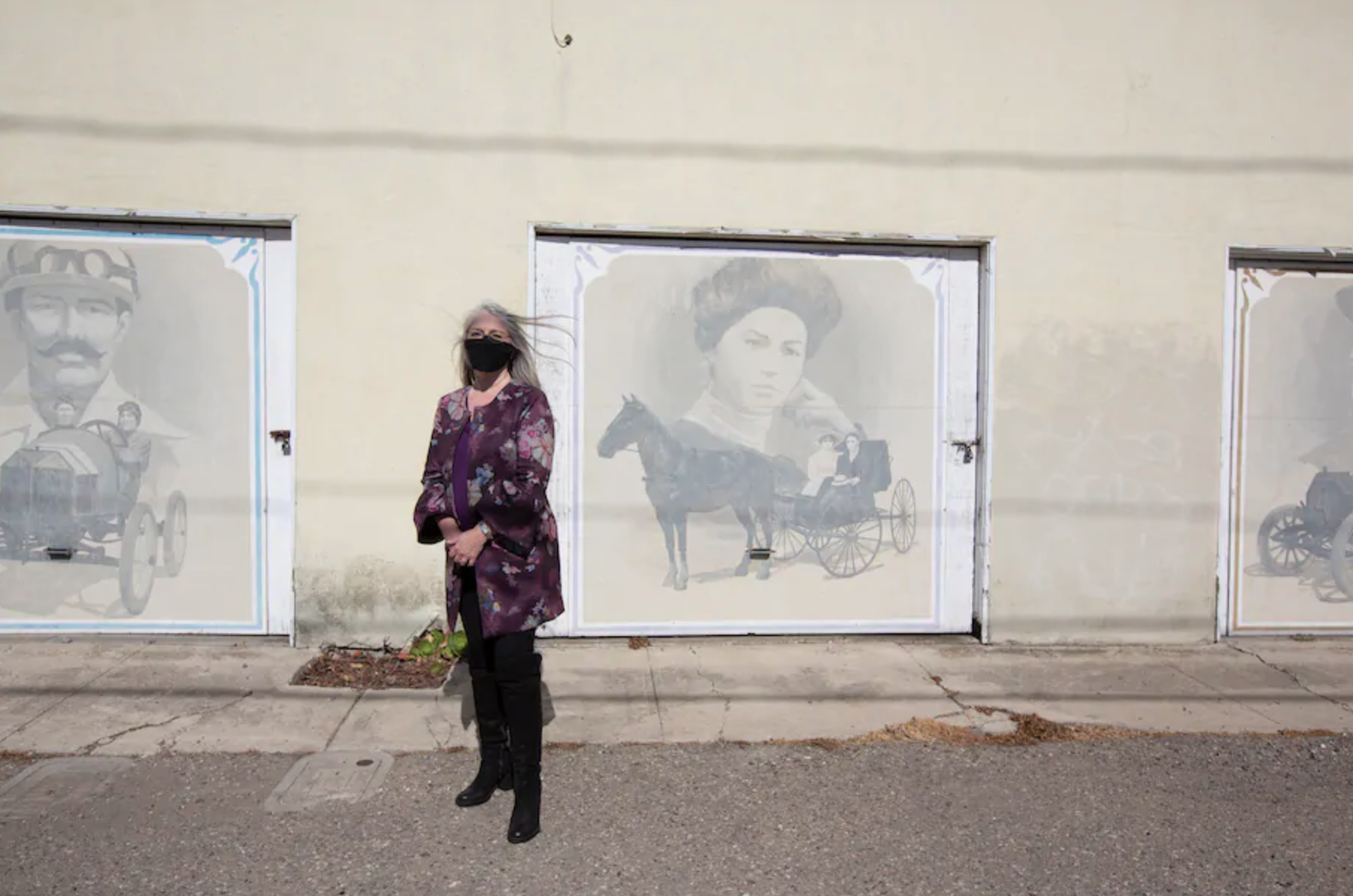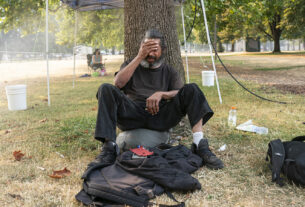
LOMPOC, Calif. — Residents of this central California agricultural community are keenly aware of their town’s reputation. Wedged in a valley just north of ritzy coastal Santa Barbara, the town established originally as a temperance colony is 30 percent low-income, had its highest number of homicides ever last year and is home to a federal prison.
The medium- and low-security prison in Lompoc has largely been seen as a bright light, offering stable jobs with good benefits. But now residents fear a new stigma they won’t be able to shake: Their town is home to the nation’s largest covid-19 outbreak in a federal prison.
“The prison is in our city limits, the sick inmates are filling our local hospital beds, yet I have no control over any of it because it’s a federal facility,” said Lompoc Mayor Jenelle Osborne. “I’m getting emails and phone calls from people who are afraid, who are asking me to do something, and I have to tell them I am powerless to do anything.”
As the coronavirus bolted through one-third of the Federal Bureau of Prisons’ 122 facilities last month, cracks began to appear in the once-symbiotic relationship between the prisons and their towns. The bureau’s fumbling of the crisis, which enabled the virus to percolate within the prisons and beyond, is stoking fear and resentment of the prisons — and sometimes of prison staff who live in those communities.
So far, 45 inmates across the country have died. The Bureau of Prisons announced April 29 that 70 percent of tests of inmates for the coronavirus have come back positive. As of Friday, 3,701 of the bureau’s roughly 140,000 inmates had tested positive. No prison personnel have died, but 527 have tested positive nationwide, according to federal data.
Residents in Lompoc and other prison towns, including Butner, N.C., and Oakdale, La., say having a prison with a high infection rate unnerves them, especially when they encounter unmasked and ungloved prison staff in grocery stores, pharmacies or restaurants.
“We have people who come in with prison uniforms two to three times a week,” said Antonio de Jesus Rodriguez, owner of Floriano’s Mexican restaurant, which provides pickup orders to customers. “Some are wearing a mask, but some are without one. It’s kind of mind-boggling. As I’m taking their order I’m thinking, ‘You are in a hot spot; why aren’t you taking this more seriously?’ ”
The Washington Post reported last month that the Bureau of Prisons allowed the virus to fester in dozens of prisons before taking action to stop its progress.
The bureau did not provide masks to correctional officers or inmates until after dozens of inmates were quarantined, and often after inmates had died. Prisoners with coughs and body aches continued to line up, just a few feet apart, for their meals and medication. And temperature checks, for both inmates and staff, did not become routine until the disease had permeated dormitory-style settings where 100 or more prisoners sleep and live within a few feet of one another.
In a statement, the bureau said it began responding to the coronavirus threat as early as January and is using “screening, testing, appropriate treatment, prevention, education, and infection control measures.”
It also said that starting April 1, it began to minimize gatherings and that “inmate movement in small numbers” is being allowed for essential activities, such as visits to the commissary, laundry, showers, telephone and health care.
The Bureau of Prisons’ mishandling of the coronavirus threat prompted Rep. Frederick B. Keller (R-Pa.) to introduce legislation May 1 that would require the bureau’s director to be confirmed by the Senate. Michael Carvajal, the current director, was appointed by the U.S. attorney general, as past directors have been.
At the Lompoc Federal Correctional Complex, two inmates have died of covid-19, 905 inmates had tested positive and 34 staff members had contracted the disease as of Friday, federal data shows. Nearly one-quarter of the covid-19 cases in federal prisons nationwide are at the Lompoc prison.
The number of inmates who have tested positive at the prison is double the number of positive cases in all of Santa Barbara County — which has reported 450 non-prison cases among its population of nearly 450,000. The prison has 2,700 inmates.
The prison’s coronavirus cases are a burden on the compact town of 40,000, where locals and the prison system share the same fire department and hospital. The mayor believes the spread of the coronavirus in the community is largely due to the prison and could have been curbed if prison leaders acted sooner and were more transparent. She estimates that nearly 60 percent of prison employees live in Lompoc.
“We’ve reached out, but either a lack of experience or lack of leadership has caused them to circle the wagons and say, ‘We will deal with it internally,’ ” Osborne said. “This secrecy does not build trust with the community.”
The Bureau of Prisons responded: “We have an open line of communication with public officials surrounding our facilities.”
The prison, though, has argued that details of how the pandemic are being handled must be kept private.
The bureau has asked local officials not to publicly disclose information regarding internal controls, the number of hospitalized inmates or the location of hospitalized inmates. “The BOP believes that such disclosure creates a security and safety risk,” reads the request obtained by The Post.
It’s a 15-minute drive from one side of Lompoc — past ranch-style homes, the heavily muraled downtown off Ocean Avenue and the railroad that runs through town — to the prison on the city’s other edge. The razor-wired top of the prison rises out of planted fields of kale, artichokes and lettuce that surround it, immediately next door to Vandenberg Air Force Base.
Five miles from the prison in downtown Lompoc, American Host Restaurant owner Dennis Block said “it’s a little scary” for him and his employees to know “that there’s 100 cases down the street.”
In April, when a local doctor donated $1,000 to the breakfast and lunch spot to provide free meals to the community, Block and his crew took steps to protect themselves.
More than 150 burritos were delivered to the local hospital, police department and convalescent home. For the prison workers, Block’s employees set up a table on the patio next to the parking lot, loaded about 50 tinfoil-wrapped burritos onto it, then watched from inside the diner until the prison worker who collected them drove away.
Block said his greatest worry isn’t exposure at his restaurant — it’s down the street from him at Lompoc Valley Medical Center, where coronavirus-infected prisoners are being treated and sometimes dying. “Basically, they are importing the virus into our community,” he said.
Nick Clay, director of the Santa Barbara County Emergency Medical Services Agency, said the prison has converted an old factory on the prison grounds into a medical ward that will treat up to 20 inmates with severe covid-19 symptoms. “They’re really taking active measures that are focused on resolving this issue,” Clay said, defending the prison response.
The Rev. Jane Quandt of the Valley of the Flowers United Church of Christ drives by the prison a few times a week. Construction of the ward did not begin until mid-April, three days before the first inmate’s death, and after many had landed in the hospital. It opened Wednesday.
Quandt said she hopes the community does not blame the prison for the spread of the virus. “This is a federal institution. So ultimately it’s got to be run by the federal administration” in Washington, she said. “This is one of their babies, and they’re not taking very good care of it, at least not here in Lompoc.”
Crossing the street
Just north of the Falls Lake reservoir sits the town of Butner in rural Granville County, N.C., about 30 miles north of Raleigh. Tidy brick and siding-wrapped homes line grid-patterned streets dating back to World War II, when it was Camp Butner.
In 2008, Butner residents opposed efforts to add a federal biodefense research center to a cluster of government-owned facilities that dominate the region. Along with the federal prison, there’s a state prison, psychiatric hospital, addiction-treatment center and a facility caring for disabled people.
At the time, Butner residents said they feared lethal pathogens — with no known treatment or vaccine — could escape the facility.
Now, similar fears have been renewed with covid-19 and the prison. As of Wednesday, seven inmates had died. At least 306 of the 4,500 inmates have tested positive, along with 39 staff members who have been infected.
In early April, Pine Grove Missionary Baptist Church introduced social distancing and protective gear to its twice-monthly food bank. As volunteers in masks and gloves carted boxes of pasta, frozen meat and canned goods to cars and trucks of local families, conversation repeatedly turned to their collective anxiety over the prison.
“They were concerned with the possible spread of the virus within the community, considering that many of the [prison] workers live in the community,” said Michelle Ross, who helps run the food bank, about six miles from the prison.
In March, the outbreak crept closer to the Rev. Marcos León of St. Bernadette Catholic Church in Butner.
Three parishioners — two nurses and a doctor working at the prison complex — told him in confidence that they were exposed on the job and had to self-quarantine at home. They were “truly afraid,” León said. “It was the fear they were going to die. Then it was: ‘I feel so bad because of my children. I’m living in a house where I have to be separated from them.’ ”
The church’s prison ministry regularly offered Mass, confession and one-on-one spiritual guidance to inmates until March, when prisons banned visitors.
Butner and Granville County officials say they don’t expect the covid-19 outbreak will alter appreciation for the prison as a local employer offering good-paying jobs. But correctional officers who live in and around Butner say they know some people fear them, said William Boseman, a retired Butner correctional officer and union representative for the officers.
When people see the prison workers in their dark-gray uniforms walking down the street, they cross to the opposite side. In grocery stores, people scoot to the next aisle.
“They are being ostracized,” Boseman said. “When people know you work at this place where there has been an outbreak, they treat you different. They treat you as if you are automatically contagious.”
Chaos and panic
The first covid-19 death of a federal inmate took place six weeks ago — on March 28 — at a prison in Oakdale, La. As of Friday, six more of the 1,800 inmates had died. There have been 115 cases of covid-19 among the prisoners and 26 among the staff.
In the boot-shaped state of Louisiana, Oakdale sits just above the ankle. About 110 miles west of Baton Rouge, past the flooded rice-field crawfish ponds of the Cajun prairie, a meandering country road lined with towering Southern pines subtly opens into a meticulously planned four-lane highway that drops you into the town of fewer than 8,000 people.
It only takes five minutes to drive from the center of town to the Oakdale Federal Correctional Complex. Along an access road to the complex, a long row of fluorescent pink and white signs with handwritten biblical psalms and motivational quotes flickers in the spring breeze: “Fear is a reaction. Courage is a decision.”
Jane Willis and her husband, Greg Willis, are in their mid-50s and have been the pastors at the Christ Church of Oakdale for 15 years. They broke ground on a new church near the prison to house their growing congregation a few months ago, before the pandemic.
As the news broke of the covid-19 outbreak at the prison, Jane Willis felt called to do something for the shift workers driving in and out of the prison complex, past their property each day. So she made signs.
“I saw the workers going back and forth and it broke my heart for them,” she said. “I was thinking of a way we can encourage them as they go to work to know they’re not alone.”
The couple’s son works at the prison, as do 15 members of their congregation. One of them, Aubrey Melder, 53, a correctional officer, said that when he saw the signs on his way to work the first time, his eyes filled with tears. Melder has felt supported by the community, but he has also felt its fear.
“When they look at you, you can tell they are uneasy,” he said, describing the few times he went to the grocery store in his uniform. “It scares them a little bit.”
Corey Trammel, a union president representing the correctional officers, said the community of Oakdale has long supported the prison workers, and he doesn’t blame them for being afraid of contracting the virus.
“I hate it for the community, and I hate it for our employees,” said Trammel. “If our prison would have let people know what was going on and our warden would have protected us and our community, then people would not have to look at us like that.”
In response, the bureau said in a statement: “We do everything we can to maintain open lines of communication with public officials. Our Executive staff are willing to discuss with them everything they are doing to combat this virus.”
Gene Paul, mayor of Oakdale and a lifelong resident, said the outbreak at the prison created chaos and left people in the community panicked. “Everyone is wondering, ‘Am I going to be next?’ ”
Paul said he now is in close contact with the warden, but he wishes the Bureau of Prisons would have handled the crisis better from the beginning. He said buses of newly sentenced inmates were continuing to arrive at the prison until a few weeks ago.
The bureau said that, overall, inmate movement is down 95 percent. However, they are legally obligated to accept new inmates brought by the U.S. Marshals Service. Those inmates are being quarantined for 14 days before entering the general prison population.
Paul estimates that half of the prison staff live in Oakdale and, although many are angry with the bureau, that rage is not directed at the people who work at the Oakdale facility.
In early April, Paul pulled a brown SUV into the Christ Church of Oakdale parking lot for a “Park and Praise” event to boost prison staff morale.
As prison employees zipped by on the access road, Paul and dozens of other Oakdale residents waved and honked their horns. Christian music blared and several people stretched their hands to the sky. A woman waved a sign that read: “Not all Heroes Wear Capes.” The prison workers smiled and waved back.
Miranda Green reported from Lompoc, Calif. Catherine Clabby reported from Butner, N.C. Marie Elizabeth Oliver reported from Oakdale, La.


